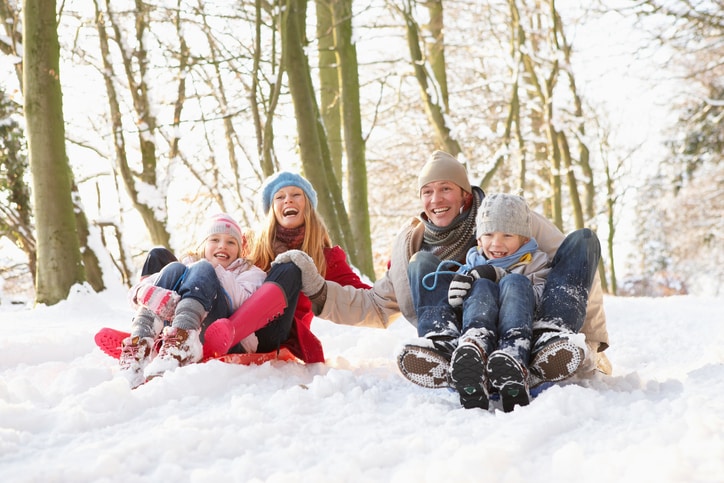
Canadian winters have a very interesting dual effect: they simultaneously push people indoors and outdoors. For some, they wish to avoid the bitter cold. For others, they wholeheartedly welcome the changing weather’s invitation to experience the great outdoors, and get involved in winter sports.
 As with most outdoor activities, there is inherent risk of serious injury with winter sports, such as tobogganing. Despite the general understanding that tobogganing can be a dangerous activity, very little research has been conducted on the prevalence of tobogganing injuries. The most recent Ontario study that this author could locate was a study regarding Ontario winter sports injuries during 2011/2012, which was conducted by the Canadian Institute for Health Information (CIHI)1. In this publication, it was determined that the third most common cause for winter sports related emergency room visits was being “struck by/against object while tobogganing”, with a total of 751 ER visits. An additional 138 ER visits were related to falls from toboggans. Over one-third (34.5%) of the tobogganing related ER visits involved injuries to the head, face or neck, with 61 noted concussions. These tobogganing accidents almost exclusively took place among children and young adults—between the ages of 5 and 19.
As with most outdoor activities, there is inherent risk of serious injury with winter sports, such as tobogganing. Despite the general understanding that tobogganing can be a dangerous activity, very little research has been conducted on the prevalence of tobogganing injuries. The most recent Ontario study that this author could locate was a study regarding Ontario winter sports injuries during 2011/2012, which was conducted by the Canadian Institute for Health Information (CIHI)1. In this publication, it was determined that the third most common cause for winter sports related emergency room visits was being “struck by/against object while tobogganing”, with a total of 751 ER visits. An additional 138 ER visits were related to falls from toboggans. Over one-third (34.5%) of the tobogganing related ER visits involved injuries to the head, face or neck, with 61 noted concussions. These tobogganing accidents almost exclusively took place among children and young adults—between the ages of 5 and 19.
This study revealed that tobogganing can be risky and cause serious injuries, but as with most other sports, most injuries are preventable. Some minor preparation and consideration can effectively preclude life-changing injuries.
Before Hitting the Slopes
Before hitting the slopes, there are a number of key considerations that should not be overlooked.
The first factor is the weather. It is best not to go out during particularly icy days. Ice reduces friction on the hill and can cause higher velocities, loss of control and a loss of potential cushioning that snow may provide for tobogganers who fall off their sleds. It is safest to sled during the daytime where visibility is less likely to be an issue. Nighttime tobogganing should be avoided, unless it takes place in very well-lit areas.
Layers of clothing not only provide relief from the cold, but they also add some protective cushioning. This can reduce the likelihood of potential injuries. Winter accessories should be tucked into coats to prevent possible injury or strangulation. For example, scarves can get caught on objects if they are dangling while going downhill.
Equipment selection and inspection is also critical. Plastics sheets (“carpets”), snow disks and snow tubes are not the safest as they do not have steering or braking mechanisms, and can be easily pierced by objects on the ground. Toboggans should be inspected prior to every usage for structural integrity and to see if there are any protruding or sharp parts.
While At The Slopes
There are some basic rules to keep in mind when you are selecting an appropriate place to toboggan.
Tobogganing should not take place on or near a public street, moving traffic, a parking lot, parked vehicles, curbs, bodies of water or fences. The tobogganing area should be free of trees, holes, jumps, and other obstacles. The ideal tobogganing hill is a designated one or a large and wide area that provides enough space so as to prevent clustering of sledders, designated areas/paths to walk back up the hill, and a moderate slope with ample room for levelling off and coming to a stop at the bottom of the hill.
Prior to starting, tobogganers should check to see if there are any posted signs. Signs may indicate that by-laws prohibit tobogganing on a particular hill or may indicate other nearby, potentially hidden, risks/obstacles.
Children under the age of 12 should be supervised. Children should be instructed on proper tobogganing form. No tobogganer should go down the hill headfirst. Sledders should also wait until their path and the bottom of the hill is clear prior to launching so as to prevent collision with other sledders. Avoid overloading the toboggan as this could cause a loss of control, higher speeds and contact injuries between the sledders on the toboggan. According to Health Canada’s recommendation, all tobogganers, particularly children, should wear helmets. Unfortunately, there is no guidance as to whether skiing, snowboarding or hockey helmets are best suited for preventing head injuries while tobogganing.
Despite taking the abovementioned precautions, accidents still happen. Sometimes, they are caused by hidden risks and may be partially attributable to the municipality. Municipalities are responsible for taking steps to make premises reasonably safe for its users. In the event of a tobogganing accident, it is best to consult with a lawyer to discuss whether there is the potential of seeking recourse against any negligent parties, including municipalities.
Stay warm, safe and enjoy the slopes!
For additional reading, visit: Can Municipalities be Held Liable for Tobogganing Accidents?
1. Cowle, S., McFaull, SR., & Subaskaran, J. (2015). Skiing, Snowboarding & Sledding: Alpine Sports Injuries in Ontario. Ontario Injury Compass, Issue 7, January 2015. Toronto: Parachute.





